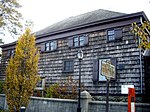Flushing High School
1875 establishments in New York (state)Educational institutions established in 1875Flushing, QueensNational Register of Historic Places in Queens, New YorkNew York City Designated Landmarks in Queens, New York ... and 4 more
Public high schools in Queens, New YorkSchool buildings on the National Register of Historic Places in New York CityUse American English from December 2020Use mdy dates from December 2020

Flushing High School is a four-year public high school in Flushing, in the New York City borough of Queens. The school is operated by the New York City Department of Education. As of the 2020-21 school year, the school had an enrollment of 1,414 students and 92.67 classroom teachers (on an FTE basis), for a student–teacher ratio of 15.26:1. There were 1,173 students (83.0% of enrollment) eligible for free lunch and 64 (4.53% of students) eligible for reduced-cost lunch.
Excerpt from the Wikipedia article Flushing High School (License: CC BY-SA 3.0, Authors, Images).Flushing High School
35th Avenue, New York Queens County
Geographical coordinates (GPS) Address Nearby Places Show on map
Geographical coordinates (GPS)
| Latitude | Longitude |
|---|---|
| N 40.765 ° | E -73.8275 ° |
Address
35th Avenue
11358 New York, Queens County
New York, United States
Open on Google Maps










